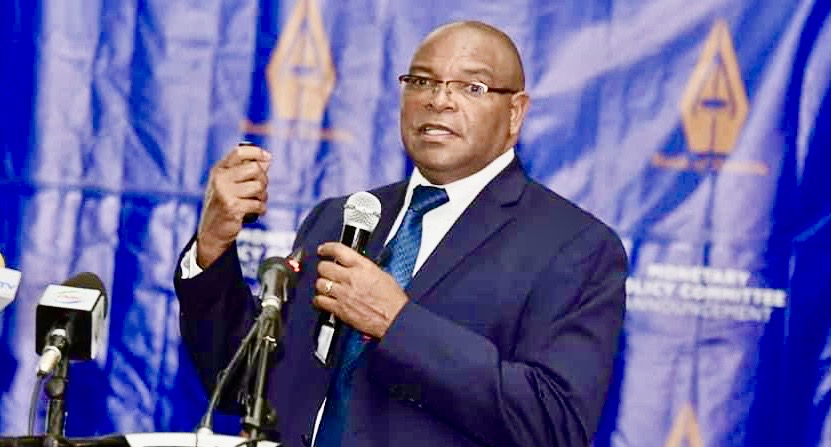LUSAKA (The Business Telegraph) – Deliberations for the third rate decision meeting commence this week for 2 after which central bank head Dr. Denny Kalyalya will announce the monetary policy stance for the next quarter. Kalyalya faces extraordinary times marred by disease pandemic that has forced central banks to expand balance sheet through quantitative easing methods while grappling to keep inflation in check and suppressing interest rates to ultra thin level to stimulate consumer demand. The copper producer faces elevated inflation, shriveling growth forecast at -5% and rising coronavirus infection cases just under 10,000. Average Lending Rates- ALR eased 211 basis points to 25.83% from last rate decision meeting while Non Performing Loans – NPLs have once again breached the prudential limit of 10% at 12.5% (K4.8billion of industry bad loans) from 9.0% in March.
Weak consumer demand. Stanbic Purchasing Managers Index -PMI reflects private sector pulse for the year lower than series average of 48.3 and has remained in the doldrums for 17 straight months with energy woes, lack of liquidity, currency depreciation and suppressed aggregate demand being key themes. COVID19 pandemic has amplified business risks which have seen unemployment spike, wage cuts widen and selling prices have suppressed significantly. An outstanding feature is that consumer demand has declined signaling need for avenues to stimulate demand which the central bank could be seeking to address this week.
Weak interest rate climb down transmission mechanism. Despite expansionary monetary policy stance over the last 5 months, interests rates have not eased as fast and effectively as expected. The Medium Term Refinance Facility – MTLRF stimulus package life line thrown to commercial banks has not achieved intended results as disbursements have dragged with only K2.95billion of the K10billion which entails banks have not had the benefit of lowering cost of funding through access cheaper funds from the BOZ. Collateral requirements and a tedious access process has delayed disbursement momentum. Other banks have shied away from the facility as they already have far cheap credit funding lines that the 100bps above MPR cost of the MTLRF. The central bank in its commitment to ensuring covid related credit risks are absorbed, has been active in Open Market Operations – OMOs injecting significant liquidity into the system.
T-bill yields falling faster than bond rates. Appetite for shorter dated government securities has remained a constant theme in a time of uncertainty given sovereign, fiscal and political risks. T-bill yields have aggressively rallied over 150bps – 385bps in the 3 months to 1 year to 14.5% – 25.4% respectively. However bond yields have remained elevated between 25% – 33% respectively. This continues to keep term funding repricing risks high. The lag in fixed income yields climbing down compared to the shorter tenors is another area the central bank will place focus on.
Homogenous challenges global central banks face. Inferring from other central banks such as the Bank of Ghana, Reserve Bank of South Africa, Bank of Kenya and Banque De Angola, expansionary monetary policy against all odds in these disease pandemic times is the way to go. These are the same quagmires that the US Federal Reserve, Bank of England, Peoples Bank of China – PBOC and other key banks face. African nations face a homogenous challenge characterized by a cocktail of debt related stress, rising or elevated inflation, currency weakness and above all lackluster growth from disease pandemic related erosions. Disease pandemic has dislocated economic metrics from the usual correlations which central banks are trying to help fix. No one ever anticipated that public health problems would be fixed with monetary and fiscal tools.
What Kalyalya’s team could do this week. Zambia’s inflation is easing and last headlined 15.8% (from a peak of 16.6% in May) as food prices fall with a bumper harvest while the currency has seen stability following foreign exchange market interventions such as dollarisation of mining taxes sucking 45-55% of supply pressure from the market. Inflation will be least of the BOZs worries in this meeting but despite the monetary policy methodology being inflation based, disease pandemic could extraordinarily force the committee to create latitude to stimulate not only consumer demand but would also accelerate the interest rate falling mechanism which seems clogged with a very slow actualization of the monetary measures the central bank earlier introduced. In that regard with a 25% likelihood we forecast a 150-200bps rate cut this week to 7.25% – 7.75%. However it is more likely that the BOZ will keep the benchmark interest rate at 9.25% which we attach a 75% while focusing on other expansionary measures such injecting liquidity in the system constantly.
The Kwacha Arbitrageur

